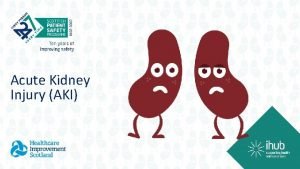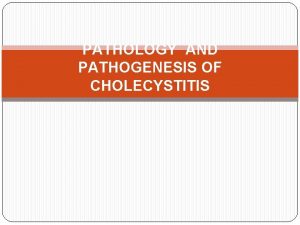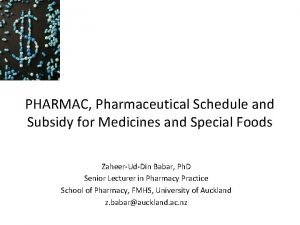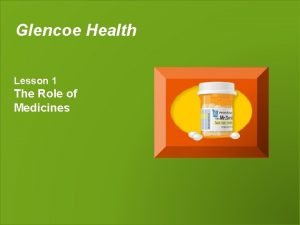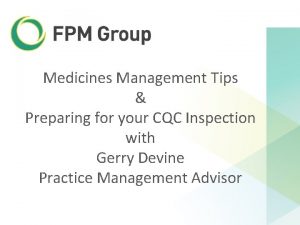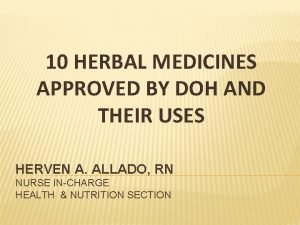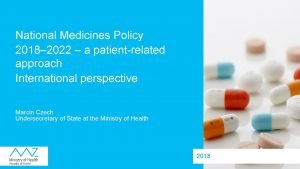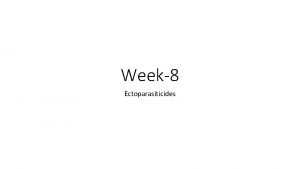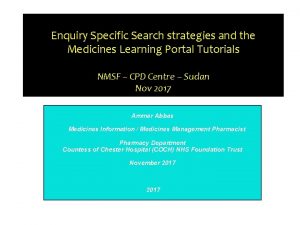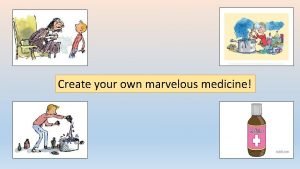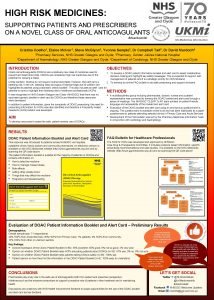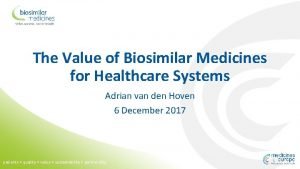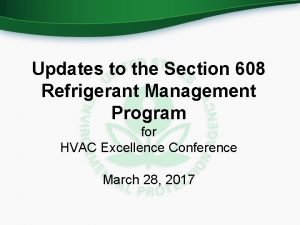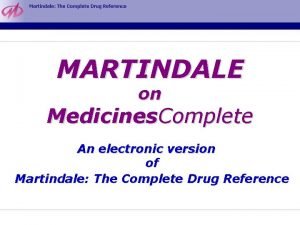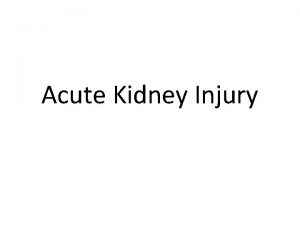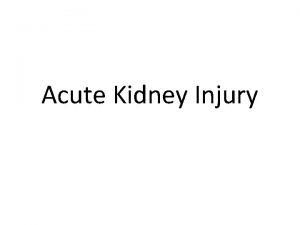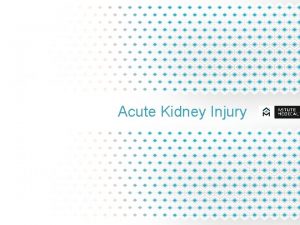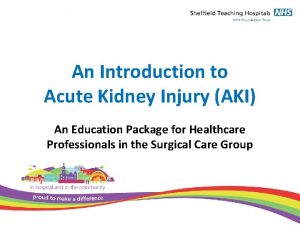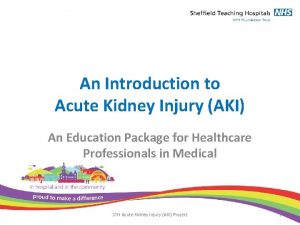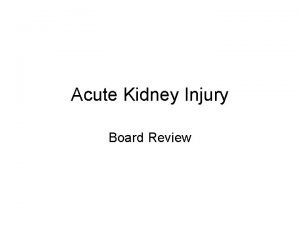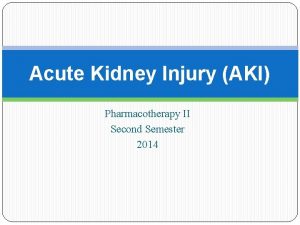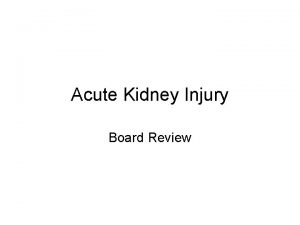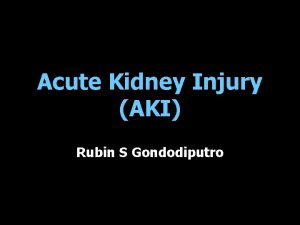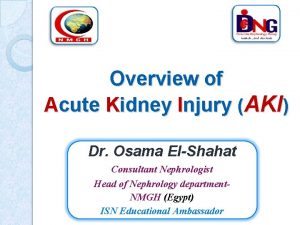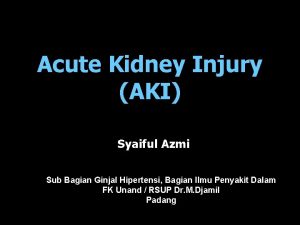Acute Kidney Injury AKI The Clinical Aspects Medicines




















- Slides: 20

Acute Kidney Injury (AKI) The Clinical Aspects & Medicines Involved Kate Webb Renal Advanced Pharmacist Practitioner University Hospital of North Midlands UK Renal Pharmacy Group

Learning Objectives n Understand what is AKI? the clinical issues associated with AKI?

Summary of Presentation n Renal Anatomy + Physiology n AKI Definition Etiology Outcomes Goals Case Study n Conclusion n

Renal Anatomy

Renal Physiology n n n Regulation of water & electrolytes Retention of substances i. e. protein / glucose Excretion of waste, H 2 O soluble & drug products Acid / base balance Endocrine function: Renin, Aldosterone, ADH Erythropoeitin, Vitamin D

AKI n Definition: ‘Abrupt ↓ in kidney function that includes, but is not limited to, Acute Renal failure. ’ n Various etiologies Kidney diseases (nephritis, vasculitis) Non-specific conditions (ischaemia) Extrarenal pathology (post-renal obstruction)

AKI – Outcomes & Goals n Outcomes: - Significant mortality & morbidity n Goals: Prevent further damage Facilitate recovery of renal function “ 20 -30% AKI is predictable & avoidable”

AKI – Prevent further damage n Identify the cause for AKI asap n Avoid nephrotoxic meds Aminoglycosides, Amphotericin, NSAIDs n Avoid nephrotoxic procedures U/S with contrast n Consider ‘drug ACEIs, ARBs holidays’

AKI – Facilitate recovery of Renal function n Identify pts who need dialysis vs. medical management n Give fluids (1. 5 l – 2 l /day) Crystalloids vs. Colloids vs. Blood n Treat cause e. g. drug toxicity n Regular monitoring n Avoid hyperglycemia

AKI – Classification & Alerts AKI Stage Creatinine Criteria Urine Output Criteria Predicted Nos / year of AKI in 1000 - bedded hospital One ↑ > 26 mmol/l above baseline (within 48 hrs) OR ↑ > 1. 5 fold from baseline < 0. 5 ml/kg/hr for at least 6 hrs 2727 Two ↑ > 2. 0 fold from baseline < 0. 5 ml/kg/hr for at least 12 hrs 782 ↑ > 3. 0 fold from baseline OR AKI with Cr > 354 mmol/l OR Initiation of Renal Replacement Therapy (RRT) < 0. 3 ml/kg/hr for at least 24 hrs OR Anuria > 12 hrs 636 Total 4145 Three

AKI – Case Study n ♂, 34 yrs. n PC Collapsed. GCS 12. On admission, Bp 54/30, Tachycardic, Resp Rate > 35, Temp 39. 6 n PMH Asthma n DHx Beclomethasone Inh + Salbutamol Inh n Implication Systemic sepsis ? cause

AKI – Case Study n Biochemistry: Na+ = 138 K+ = 7. 2 Urea = 56. 2 Cr 784 = CRP 160 =e. GFR 11 = Hb 126 = WBC 33. 6 Plts 156 == Alb = 39 Calcium = 2. 2 Phosphate = 1. 3

AKI – Case Study n Biochemistry: Na+ = 138 K+ = 7. 2(High) Urea = 56. 2 (High) Cr = 784 (High) e. GFR = 11 (Low) CRP = 160 (High) Hb=126 WBC=33. 6(High) Plts = 156 Alb = 39 Calcium = 2. 2 Phosphate = 1. 3

AKI – Classification & Alerts AKI Stage Creatinine Criteria Urine Output Criteria Predicted Nos / year of AKI in 1000 - bedded hospital One ↑ > 26 mmol/l above baseline (within 48 hrs) OR ↑ > 1. 5 fold from baseline < 0. 5 ml/kg/hr for at least 6 hrs 2727 Two ↑ > 2. 0 fold from baseline < 0. 5 ml/kg/hr for at least 12 hrs 782 ↑ > 3. 0 fold from baseline OR AKI with Cr > 354 mmol/l OR Initiation of Renal Replacement Therapy (RRT) < 0. 3 ml/kg/hr for at least 24 hrs OR Anuria > 12 hrs 636 Total 4145 Three

AKI – Case Study n CXR R + L sided consolidation Pneumonia (? Microbiology) n Hypoxic + Acidotic Ventilated (Level 3 care) n Urine Output 12 ml/hr, 5 ml/hr, 6 ml/hr (Pt wt = 80 kg) Filter (Level 3 care) CVVHDF

AKI – Classification & Alerts AKI Stage Creatinine Criteria Urine Output Criteria Predicted Nos / year of AKI in 1000 - bedded hospital One ↑ > 26 mmol/l above baseline (within 48 hrs) OR ↑ > 1. 5 fold from baseline < 0. 5 ml/kg/hr for at least 6 hrs 2727 Two ↑ > 2. 0 fold from baseline < 0. 5 ml/kg/hr for at least 12 hrs 782 ↑ > 3. 0 fold from baseline OR AKI with Cr > 354 mmol/l OR Initiation of Renal Replacement Therapy (RRT) < 0. 3 ml/kg/hr for at least 24 hrs OR Anuria > 12 hrs 636 Total 4145 Three

AKI – Case Study n Pneumonia Abx broad + empirical Co-Amoxiclav + Clarithromycin n Ventilated Sedated Morphine + Midazolam vs. Alfentanyl + Propofol n CVVHDF Effects on drug dosing / Clotting / Dialysis fluids n Fluids ? Give / Type n Others VAP meds / GI protection / TEDs

AKI – Case Study 11 Days later…. . n U&Es: Na+ = 138 K+ = 4. 3 Urea = 11. 2 (High) Cr = 284 (High) e. GFR = 32 (Low) CRP = 32 (High) Hb = 126 WBC = 13. 6 (High) n Urine Output: - 42 ml/hr, 54 ml/hr, 47 ml/hr n Pt Discharged n Meds: - Co-Amoxiclax 625 mg TDS for 4 days Clarithromycin 500 mg BD for 4 days Paracetamol 1 gram QDS PRN Becotide® 100 ii puffs BD Salbutamol 100 PRN n

Conclusion n Renal Anatomy + Physiology n Understanding of AKI n AKI Prevent further damage Facilitate recovery n AKI application in Practice

Questions
 Acute kidney injury
Acute kidney injury Aki kifelé tekint álmodik aki befelé az ébred
Aki kifelé tekint álmodik aki befelé az ébred Examples of intentional injury
Examples of intentional injury Cholecystitis pathogenesis
Cholecystitis pathogenesis Parodontitis apicalis acuta
Parodontitis apicalis acuta Basket system of distribution of medicines
Basket system of distribution of medicines Pharmac schedule pdf
Pharmac schedule pdf Nhs dictionary of medicines and devices
Nhs dictionary of medicines and devices Chapter 19 lesson 2 using medicines safely
Chapter 19 lesson 2 using medicines safely Cqc medicines management
Cqc medicines management Health benefits of niyog-niyogan
Health benefits of niyog-niyogan National medicines policy
National medicines policy Ectoparasiticides veterinary medicines
Ectoparasiticides veterinary medicines Medicines learning portal
Medicines learning portal Staff of marvelous medicines
Staff of marvelous medicines Medicines information centre
Medicines information centre European directorate for the quality of medicines
European directorate for the quality of medicines Ggc medicines
Ggc medicines Abasagar
Abasagar Refrigerant management program
Refrigerant management program Medicines complete martindale
Medicines complete martindale
